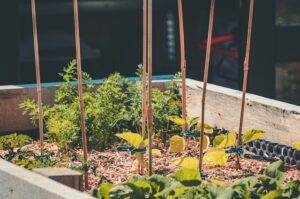In today’s fast-paced world, urban spaces are increasingly being transformed into pockets of green. For budding gardeners, especially those with limited time and space, the idea of growing vegetables might seem daunting. Enter the plant-and-forget vegetables gardening philosophy—a low-maintenance approach that promises a lush, productive garden with minimal effort. This guide will show you how to cultivate fresh produce even in the busiest urban settings.
The Appeal of Low-Maintenance Vegetable Gardening
Gardening can be a therapeutic hobby, but many shy away from it due to time constraints or lack of expertise. However, with plant-and-forget vegetables, the hurdles of traditional gardening vanish. These vegetables are as easy to grow as they sound—simply plant them and, for the most part, forget about them until they’re ready to harvest. This makes them perfect for both novices eager to start their gardening journey and seasoned gardeners looking for a low-effort alternative.
The core of this gardening style lies in sustainability. By focusing on vegetables that thrive with minimal intervention, you’re not just saving time, but also water and resources, making it an eco-friendly choice for sustainable living enthusiasts.
Benefits of Plant-And-Forget Vegetables
Minimal Care Requirements
One of the biggest draws of plant-and-forget vegetables is their hardiness. They are well-suited for those who might not have the luxury of time to tend to a garden daily. Once established, these plants require little more than occasional watering and weeding, allowing you to reap the benefits without constant oversight.
Ideal for Busy or Novice Gardeners
For beginners, the complexity of gardening can be overwhelming. These low-maintenance vegetables offer a gentler introduction to the world of horticulture, building confidence without demanding too much effort. Equally, for city dwellers with limited free time, these vegetables provide an opportunity to enjoy home-grown produce without the need for a green thumb.
Sustainable Gardening Practices
Plant-and-forget gardening aligns perfectly with sustainable practices. It encourages efficient use of resources by reducing water consumption and minimizing the need for chemical fertilizers. By choosing hardy vegetables, you’re also supporting biodiversity and promoting healthier soil ecosystems.
Examples of Plant-And-Forget Vegetables
Zucchini
Zucchini is a prolific producer, thriving with little intervention once it’s planted. Just plant the seeds in a sunny spot, water occasionally, and watch them grow. These vibrant green vegetables are perfect for adding to salads, stir-fries, or spiralizing into noodles.
Kale
Known for its nutritional value, kale is a powerhouse in the garden. It’s hardy and resilient, continuing to produce leaves even when neglected. Plant it in a well-drained area, and it will reward you with a continuous supply of leafy greens.
Garlic
Garlic is a quintessential plant-and-forget vegetable. Plant the cloves in the fall, and nature takes care of the rest. Come spring, you’ll be greeted with shoots that signify the bulbs are growing underground, ready for harvest by summer.
Carrots
These root vegetables are fuss-free after planting. Ensure the soil is loose and well-drained, then sow the seeds. With minimal attention, you’ll be pulling up sweet, crunchy carrots in no time.
Beets
Beets are both easy to grow and beneficial to health. They require little more than occasional watering and thinning. Their roots and greens are excellent in salads and juices alike.
Swiss Chard
Once planted, Swiss chard needs little care and will produce vibrant, nutritious leaves throughout the season. It’s a versatile addition to your garden and your diet, perfect for sautéing or adding to soups.
Potatoes
Potatoes are a staple in many diets and surprisingly easy to grow. Plant them in well-draining soil, cover with mulch, and they’ll thrive with minimal oversight until it’s time to dig them up.
Pumpkins
After the initial planting, pumpkins grow vigorously, especially if mulched. They not only provide delicious fruit for pies and soups but can also be carved come Halloween.
Butternut Squash
Butternut squash is a favorite for its sweet flavor and ease of growth. Once the vines get established, very little is required besides the occasional check-in to ensure they have room to sprawl.
Sweet Potatoes
These tubers thrive in warm soil. Once planted, they require minimal maintenance, and before you know it, you’ll have a bountiful harvest for roasting or mashing.
Cucumbers
Cucumbers are another easy-grow vegetable that rewards with plentiful fruit. With proper support and occasional watering, they’ll keep producing throughout the summer.
Green Beans
Green beans are easy to grow and require little care after planting. They climb readily and will keep producing as long as you keep picking them.
Radishes
Radishes are among the fastest-growing vegetables. With minimal maintenance, they’re ready to harvest in just a few weeks, providing a peppery crunch to any dish.
Tips for Successful Plant-And-Forget Gardening
Choose the Right Plants
Not all vegetables thrive in every climate. Select varieties suited to your local environment and soil type for the best results. Check with local gardening centers for advice on what grows best in your region.
Properly Prepare the Soil
The key to a successful garden lies in the soil. Make sure to enrich it with compost or well-rotted manure to provide essential nutrients for your plants. A well-prepared soil bed will give your vegetables the best start.
Use Mulch
Mulching is an excellent way to conserve moisture and suppress weeds. It reduces the need for frequent watering and keeps your garden bed tidy and efficient.
Water Deeply but Infrequently
Once your plants are established, water them deeply but less often. This encourages them to develop strong root systems that can access water deeper in the soil.
Utilize Companion Planting
Companion planting can optimize growth and reduce pest issues naturally. Research which plants benefit each other when grown together and incorporate these pairings into your garden.
Harvesting and Enjoying Your Produce
Knowing when to harvest is crucial for enjoying the full flavor of your vegetables. Each type has its own indicators of readiness, whether it’s the color, size, or firmness. Regularly check your plants, and you’ll soon become familiar with these signs.
Once harvested, these home-grown delights can be enjoyed in countless ways. From fresh salads to hearty stews, the fruits of your minimal labor will taste even better knowing you grew them yourself.
Conclusion
Growing a plant-and-forget garden offers numerous benefits beyond a bountiful harvest. It’s a sustainable, cost-effective way to enhance your urban living space while connecting you to nature’s rhythms. Whether you’re a busy city dweller or a beginner gardener, these hardy vegetables provide a rewarding gardening experience without the fuss.
Ready to dig in and transform your space into a verdant retreat? Try your hand at plant-and-forget gardening and discover the joys of effortless cultivation. For more gardening tips and advice, be sure to explore our resources geared toward making gardening accessible and enjoyable for everyone. Start small, plant mindfully, and grow with confidence.

